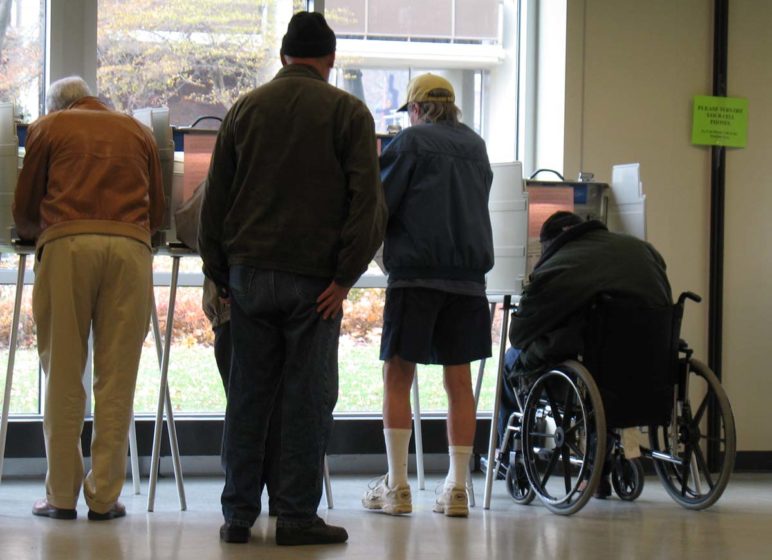Donald Trump chooses to cast his ballot by mail. As he should. He’s busy; it’d be tough for him to get to Florida every election day. Mail-out ballots are a secure, convenient way to exercise your right to vote when your job or other circumstances life throws at you make it difficult—or impossible—to get yourself to your assigned polling place on a work day. As American voters anticipate a high-stakes general election right around the time experts expect an autumn resurgence of COVID-19 cases, it makes sense that they want to enjoy the same luxury—and safety—the president himself takes advantage of. With 7 in 10 Americans feeling like going to the grocery store is a risky act, it’s no wonder public opinion polls show that around the same number want the option to vote by mail.
With 7 in 10 Americans feeling like going to the grocery store is a risky act, it’s no wonder public opinion polls show that around the same number want the option to vote by mail.

With the Centers for Disease Control and Prevention recommending “postal balloting” to reduce crowd size at polling stations, one public opinion shop declared that “the pandemic has changed how people want to vote in this democracy.” A slew of polls from April bears this out, and uncovers surprising partisan unity despite some conservative leaders poo pooing vote by mail proposals—Trump chief among them.
Multiple polls show support for expanding Vote By Mail options
A Wall Street Journal/NBC News poll found that two-thirds of voters—67 percent—favor voting by mail on Election Day 2020. Just 29 percent disagree. And 58 percent of voters support making the switch to voting by mail permanent. Of the 39 percent who don’t want a permanent change, one quarter would still like to see mail-in ballots available this fall.
A mid-April Harvard-Harris survey found that 72 percent of respondents backed conducting the presidential election entirely by mail in all 50 states, while just 28 percent opposed the idea (respondents were reminded that states like Washington and Oregon already run all elections entirely by mail.) And an early April Democracy Corps survey of 2,000 people in 16 battleground states (conducted for the nonpartisan Center for Voter Information), found that 73 percent favor no-excuse absentee voting—that is, allowing voters to request an absentee ballot “regardless of the reason” instead of requiring an “excuse” as a handful of state still do. Two-thirds of voters in these battleground states support every voter simply being mailed an absentee ballot (66 percent). Sixty-eight percent want all voters to vote by mail on Election Day.
A Navigator Research survey found broad, bipartisan support for expanded vote-by-mail—71 percent of respondents. Around the same share—69 percent—agree that the “pandemic should not force people to choose between voting and their health,” while just 31 percent agree with the naysayers that expanding vote by mail “increases voter fraud and reduces electoral credibility.” Among Trump supporters surveyed, fully half— 52 percent—find it “very” or “somewhat” concerning that they might be unable to vote by mail in the fall. And 40 percent of respondents who voted for Trump in 2016 find it “very” or “somewhat” concerning that “Senate Republicans are blocking access to vote by mail.”
US voters are unified behind safer voting choices
American voters are rarely so unified—especially when public discourse on voter protections in the face of the pandemic remains divisive. Partisan differences still exist (in the WSJ/NBC poll, the most ambitious move to make Vote By Mail permanent garnered support from 82 percent of Democrats and 61 percent of independents, but just 31 percent of Republicans.) But more often, across surveys, support for Vote By Mail measures to protect voters this year stayed above 50 percent among conservatives and in the mid-60s for independent voters. In the Center for Voter Information survey, of the 68 percent who’d like to see every voter vote by mail in November, 83 percent were Democrats while 51 percent were Republicans. In fact, nearly every effort to make it easier to vote in November was supported by a majority of Republicans in that poll.
Pew polling from April also finds broad public support for giving voters the option to vote by mail, and, more generally, they track approval making gains for ultimately conducting all elections by mail. They found that 70 percent favor allowing any voter to vote by mail if they want to right now, including 44 percent who strongly support this policy. Black and Hispanic adults (79 percent in each group) are more supportive of the proposal than white adults (66 percent). When it comes to the idea of switching to all vote by mail elections, all the time, half of Americans are on board, an increase of 18 percentage points since 2018. Conservative voters’ support for conducting all elections by mail is moving slower than progressives’ support, but nonetheless inching up.
Try Vote By Mail, you’ll probably like it
While Pew’s survey found partisan distinctions, they uncovered telling data about conservative voters who’ve had more experience with mail-in ballots. Breaking down support for letting people vote by mail if they prefer to by the prevalence of vote-by-mail in the respondent’s state, Pew found that conservatives who live in states where it’s easier or more prevalent to vote by mail overwhelmingly favor it. Democratic-leaning voters remained consistent between states with little Vote By Mail and lots of it. But with Republicans, there is a sizable variance: “The ones with the most experience with this method are quite happy with it.” In states with sparse mailed ballot options in the 2018 election, just 40 percent of Republican-leaning voters “strongly” or “somewhat” favor expanding Vote By Mail. That number ticks up to 47 percent in states with a medium amount of existing Vote By Mail. “But when you ask GOP-leaning voters in states with lots of vote-by-mail whether they support it, the number leaps to 68 percent.”
Americans “vote with their feet”—or in this case they demonstrate their preference by opting to put their feet up and vote comfortably from home.

Just so, regardless of public opinion, when it comes to preferences about casting their ballots, Americans “vote with their feet”—or in this case they demonstrate their preference by opting to put their feet up and vote comfortably from home. In states that use mail ballots exclusively, more people vote—turnout goes up. Almost a quarter of the electorate, more than 23 percent of all voters, cast their ballots by mail in the 2016 general election. And the numbers are on the rise. (That’s twice as many mail-in ballots as 2004). And despite claims about party advantage one way or the other, in 2016, the same share of Democrats and Republicans voted by mail.
No past partisan advantage with Vote By Mail—and no precedent for pandemic elections
Granting voters more freedom to vote by mail does not favor one party over another. Republicans often express fear that higher turnout generally advantages progressive candidates, boosting participation by younger people and people of color who lean left. But other evidence contradicts this. NPR reports that in Florida, for example, a state nearly evenly divided among Republicans, Democrats and independents, elections are often decided by the narrowest of margins and in many local and state-wide races mail-in ballots have provided Republican candidates with the votes to win. Various reports suggest turnout increases could benefit either Democrats or Republicans. The biggest study yet, a Stanford comparison voter data in three states with staggered rollouts of Vote By Mail programs (providing convenient county-by-county control groups), California, Utah and Washington, dispels concerns about an increased mail-in voting causing any shift toward one party or another. Researchers found that the introduction of mail-out voting did not have an effect, on average, on the share of voter turnout for either Republicans or Democrats. Expanding Vote By Mail, they concluded, does not appear to increase the vote share for candidates of either party.
In any case, past trends may not be an accurate guide this year. Pandemic elections have no track record. With particular health vulnerabilities to coronavirus among older voters who are more likely to lean conservative, some experts caution that Republican rejection of safe voting methods like Vote By Mail could suppress turnout among their most loyal base voters. The conservative psychology may even be particularly favorable to the clean, tidy, controlled option to vote from home.

Amid the coronavirus scare, voters may prefer to Vote By Mail. Photo Credit: .michael.newman. Flickr via Compfight cc
Americans of all stripes fear election disruptions in November
In any case, this year, amid coronavirus fears, concerns about staying healthy and complying with stay home orders may trump partisan hype about how we conduct elections. Nine in ten voters in key battleground states believed social distancing was the right thing to do and joined it, regardless of party. Despite what they’re hearing from party leaders about measures to safeguard elections, Republicans are social distancing along with voters of other persuasions—87 percent, according to the battleground state polling. Another Navigator poll found that only 25 percent of Republicans said there were too many coronavirus-related restrictions in the area where they live. With around six months until Election Day, two-thirds of Americans (67 percent) say it is very or somewhat likely that the coronavirus outbreak will significantly disrupt people’s ability to vote in the presidential election, including over half of Republicans.
This context and people’s sentiments may change as November nears. And the calculus—and rhetoric—may shift about which party gains more momentum with expanded voting options. But in the end, Americans want to vote as president Trump does—not as he says they should. Americans of all stripes want to exercise their right to vote—and to do it safely. Vote By Mail is looking like a good option.











Tracy
I DO NOT want mail in voting… That is not a way to prove U.S. citizens.. How would they show I.D.? I am tired of people from other countries voting for “OUR” PRESIDENT!!!!!